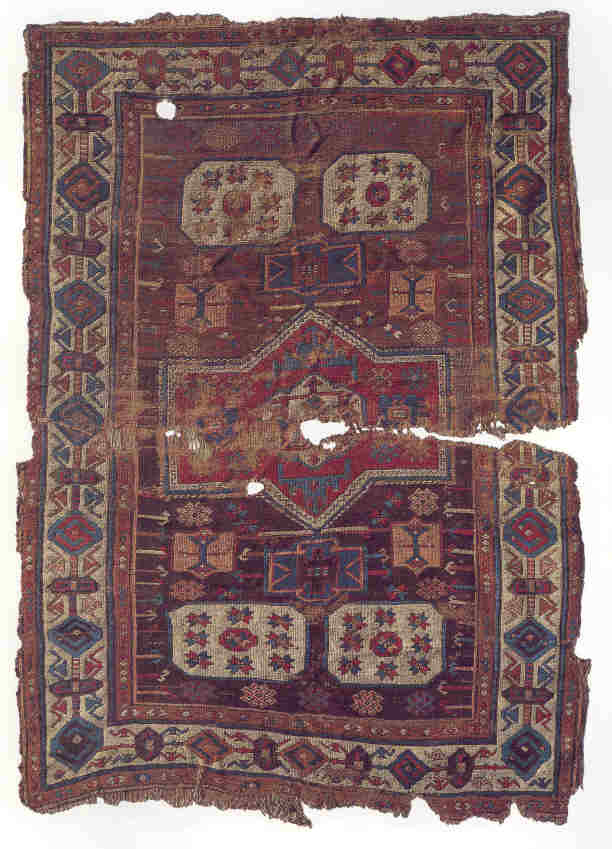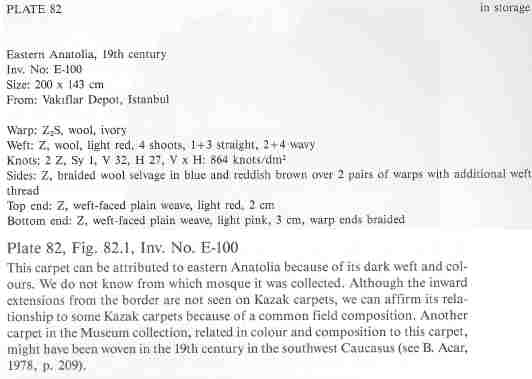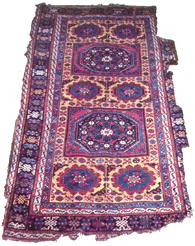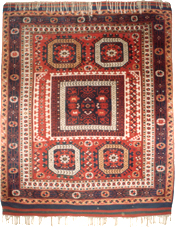Posted by Rudolf Hilbert on 01-06-2002 04:39 PM:
two one two design
Dear all,
I think there is a close relationship between the Karachov design and a distinctive rather narrow brown ground
two-one-two subgroup which is generally located to East Anatolia and attributed to Kurdish weavers.
To illustrate this, please take a look at pl. 82 from Balpinar/Hirsch (Vakiflar Museum Istanbul):


Another example of this subgroup but now with a leaf and calyx border is shown in Rippon Boswell 19.May 2001, No.
155:

Is it possible that the Karachov design was introduced to the Caucasus by east Anatolian Kurdish weavers,
or was it invented independently in late 18th ct. ? I doubt the latter.
Regards,
Rudi
Posted by Steve Price on 01-06-2002 05:54 PM:
Hi Rudi,
It's hard to know whether one is the ancestor of the other (or if both derive from the same other source), but
I agree that the relationship between the two is very obvious.
Regards,
Steve Price
Posted by Filiberto Boncompagni on 01-07-2002 11:51 AM:
Dear Rudy,
Very interesting. That fits with my opinion that Armenians AND Kurds are at the origin of the "lexicon"
of the Caucasian design.
Regards,
Filiberto
Posted by Wendel Swan on 01-15-2002 10:03 PM:
Dear Daniel,
You refer to your Karachov as "the earliest Kazak Karachov I have ever handled. It predates the 1860-1870
boring workshop products woven under Russian influence and control for export."
Perhaps there is something about it that I am missing, but I'll offer you my comments. To me, the design looks
like a devolution of the standard form Karachov, not an earlier version. I would expect the oldest group of Karachovs
to look more like the rugs of the Holbein groups of 2-1-2 patterning, with the "2" elements being larger
in relationship to the central medallion than yours are.
Following is an image of a 16th Century Holbein Type IV rug from the Museum of Islamic and Turkish Arts in Istanbul
illustrating this relationship. In some examples of 2-1-2 patterning, the elements are all of virtually the same
size.

Next is a large pattern Holbein from the 19th Century (arguments could be made placing it anywhere from around
1840 to 1880). Enough of these exist that we know some are more curvilinear than others and some have synthetic
dyes, but the 2-1-2 relationship remains relatively constant.

Rudi has shown two East Anatolian rugs (let's just call them Kagizman, whether that's accurate or not) that are
also probably from this same time period. While there are deviations in some of these examples, I can't recall
seeing any woven outside what some call the "cochineal era" of Turkish weaving and the 2-1-2 relationship
in them also remains relatively constant.
A lot of Karachovs still exist, so they must have been woven in quantity and probably in more than one area. My
general impression is that they are, as a group, maybe a little later than their Turkish counterparts. In any event,
I don't think I've ever seen a Karachov that could be from before 1850 and most are at least after 1880.
An argument could be made that the 2-1-2 Bergama above, the Karachovs and the Kagizman 2-1-2 variations are all
of roughly the same age. While they all are related and presumably come from the Holbein group, trying to trace
the paths and order in which they appeared seems nearly impossible. It could be that the Armenians who moved from
Anatolia into the Caucasus carried the 2-1-2 format with them from Anatolia, but it needn't have been Armenians
nor would it necessarily have to be a cultural or ethnic occurrence.
Given the regional wide resurgence of weaving, I think that it is possible that the Bergama, Kagizman and Karachov
versions of 2-1-2 may have been separate commercial interpretations that were all conceived at that time and frequently
copied.
If that sounds hard to believe, consider the "Lesghi star" motif that is found in various Caucasian weaves
and Shahsavan sumak bags. You cannot find a "Lesghi star" rug from 1850 or before. You'll find lots of
ancient eight-pointed stars in Turkish rugs but not "Lesghi stars." Having studied the matter at some
length, I'm convinced that the "Lesghi star" must have been created for commercial production in the
last half of the 19th Century. Why isn't the Karachov simply a commercial adaptation of an old design continuum?
Sorry for rambling.
Wendel
Posted by Patrick Weiler on 01-16-2002 09:46 AM:
Continuum
Rudi,
The topic of design introduction and transfer between eastern Anatolia and the Caucasus is just as fraught with
pitfalls as the Persian/Caucasian relationship. Northeastern Anatolia was part of the Armenian "empire"
and the boundaries were still fluid until the first quarter of the 20th century.
The 2-1-2 design is even still extant in many Fachralo prayer rugs. They magnify the central star and add the mihrab
and keyhole reentry, but they retain vestigal minor ornaments in the field that correspond to the minor "guls"
of the Holbein versions.
There is a picture of a Fachralo with this "minor two-big-One-minor-two" design here:
http://www.solent.ac.uk/fineartsvaluation/catalog/sx030006.htm
There are two small red figures in the field near the top and two larger figures below the main "star".
Speculation of what came first also ties into the relationship between the second Holbein version shown by Wendel
above and the variety of Turkmen weavings made from the 17th to 20th centuries.
They didn't have computer software back then, so instead of using Photoshop to change things, they just wove them.
Patrick Weiler
Posted by Deschuyteneer daniel on 01-16-2002 11:23 AM:
Dear all,
Wendel’s argumentation is really convincing. It’s logical to admit that the design and more important the design
balance in the earliest pieces are closer to their original (Turkish) prototype.
The Karachov rug I present in my essay is more probably an Eastern Anatolian, Kagizman version than a Caucasian
one. The wool, the colors, the overlapping knotting in the borders and a more freely tribal rendition of the design
are in favor of this attribution.
I told it was the earliest Karachov I handled only to be provocative and to raise interesting argumentation.
To my recollection Mike Tschebull, author of “Kazak”, proposed two other indicators which would be in favor of
an early attribution. One is the fineness of knotting, the other one is the presence of two reds.
Any thoughts ?
Thanks,
Daniel
Posted by Wendel Swan on 01-16-2002 11:54 AM:
Hi Daniel,
I've heard Mike express the opinion that greater fineness is an indication of greater age and I think he has also
made a similar argument about the number of colors, not just reds.
It is clear that as Kustar production in the Caucasus ramped up, the knot count and the number of colors both declined
(generally speaking, of course).
While we could easily conclude that relatively fine rugs with a dozen or more colors are outside the typical Kustar
production, I don't see these quality factors as necessarily being age dependent.
Wendel




